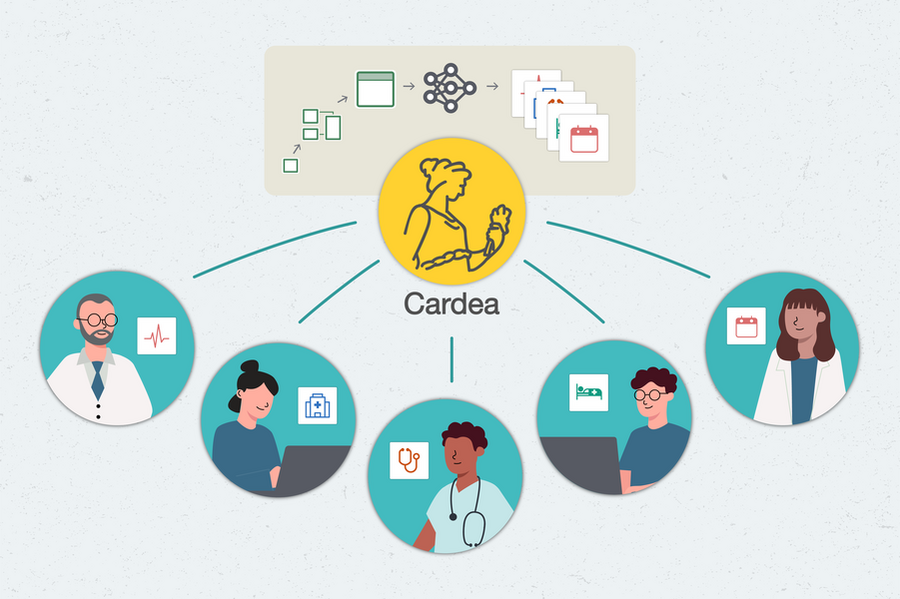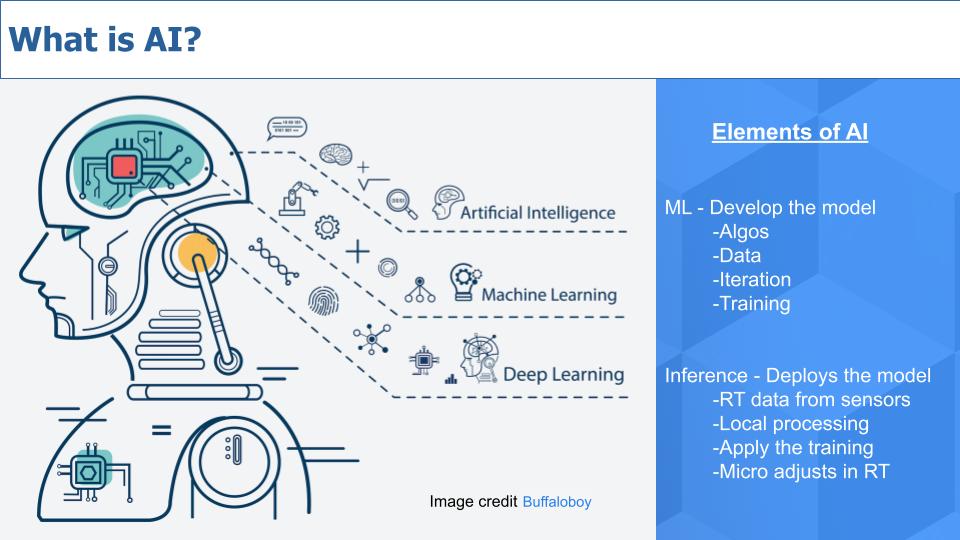One-stop machine learning platform turns health care data into insights

To turn reams of data into useful predictions, Cardea walks users through a
pipeline, with choices and safeguards at each step. They are first greeted by a
data assembler, which ingests the information they provide. Cardea is built to
work with Fast Healthcare Interoperability Resources (FHIR), the current
industry standard for electronic health care records. Hospitals vary in exactly
how they use FHIR, so Cardea has been built to "adapt to different conditions
and different datasets seamlessly," says Veeramachaneni. If there are
discrepancies within the data, Cardea's data auditor points them out, so that
they can be fixed or dismissed. Next, Cardea asks the user what they want to
find out. Perhaps they would like to estimate how long a patient might stay in
the hospital. Even seemingly small questions like this one are crucial when it
comes to day-to-day hospital operations — especially now, as health care
facilities manage their resources during the Covid-19 pandemic, says
Alnegheimish. Users can choose between different models, and the software system
then uses the dataset and models to learn patterns from previous patients, and
to predict what could happen in this case, helping stakeholders plan ahead.
8 Ways Digital Banking Will Evolve Over the Next 5 Years

The initial shift toward digital financial services saw an ad hoc response from
regulators. As new technologies come into play and tech giants like Google and
Apple become increasingly disruptive in the financial industry, these
transformations will force policymakers to identify emerging threat vectors and
comprehensively address risk. In contrast to today’s mostly national systems of
oversight, a global approach may be necessary to ensure stability in the sector,
and we may see the rise of new licensing and supervisory bodies. The future of
digital banking appears bright, but the unprecedented pace of innovation and
shifts in consumer expectations demand a new level of agility and
forward-thinking. Even as financial institutions attempt to differentiate
themselves from competitors, co-innovation will become an integral part of
success. People and technology will both play critical roles in these
developments. Tech capabilities and digital services must be extremely
resilient, constantly available at the time of customer need. Human capital,
however, will be as crucial as any other asset. Leaders will have to know how to
upskill, reskill and retain their talent to promote innovation.
A new era of innovation: Moore’s Law is not dead and AI is ready to explode

We sometimes use artificial intelligence and machine intelligence
interchangeably. This notion comes from our collaborations with author David
Moschella. Interestingly, in his book “Seeing Digital,” Moschella says “there’s
nothing artificial” about this: There’s nothing artificial about machine
intelligence just like there’s nothing artificial about the strength of a
tractor. It’s a nuance, but precise language can often bring clarity. We hear a
lot about machine learning and deep learning and think of them as subsets of AI.
Machine learning applies algorithms and code to data to get “smarter” – make
better models, for example, that can lead to augmented intelligence and better
decisions by humans, or machines. These models improve as they get more data and
iterate over time. Deep learning is a more advanced type of machine learning
that uses more complex math. The right side of the chart above shows the two
broad elements of AI. The point we want to make here is that much of the
activity in AI today is focused on building and training models. And this is
mostly happening in the cloud. But we think AI inference will bring the most
exciting innovations in the coming years.
Rethinking Ecommerce as Commerce at Home

Ecommerce is all grown up. It’s time to break away from the early-internet
paradigm where online shopping was a new, “electronic” form of shopping. Today,
almost all commerce involves varying degrees of digital elements (discovery,
price comparison, personalization, selection, ordering, payment, delivery,
etc.). The defining factor is not whether commerce is digital; rather, one
defining factor is the optimal location for a retailer to meet a consumer’s
needs. Shopping happens on a spectrum between home and the store. As such,
ecommerce is better understood as commerce at home, and Amazon was the early
winner. Great retailers focus on convenience or the experiential. In the new
paradigm, certain retail truths persist. For example, all great retailers have
focused primarily on either convenience retail or experiential retail. To be
clear, any retail can be a great experience, but the priority matters. Amazon
focuses ruthlessly on convenience. The outcome is a great customer experience.
To drive growth, Amazon has prioritized speed and selection over consultation
and curation. Amazon’s focus on convenience has yielded an (incredibly)
high-volume, low-margin retail business.
These are the AI risks we should be focusing on

AI may never reach the nightmare sci-fi scenarios of Skynet or the Terminator,
but that doesn’t mean we can shy away from facing the real social risks today’s
AI poses. By working with stakeholder groups, researchers and industry leaders
can establish procedures for identifying and mitigating potential risks without
overly hampering innovation. After all, AI itself is neither inherently good nor
bad. There are many real potential benefits that it can unlock for society — we
just need to be thoughtful and responsible in how we develop and deploy it. For
example, we should strive for greater diversity within the data science and AI
professions, including taking steps to consult with domain experts from relevant
fields like social science and economics when developing certain technologies.
The potential risks of AI extend beyond the purely technical; so too must the
efforts to mitigate those risks. We must also collaborate to establish norms and
shared practices around AI like GPT-3 and deepfake models, such as standardized
impact assessments or external review periods.
India Inc. must consider Digital Ethics framework for responsible digitalisation

An accelerated pace of digital transition, consumption of goods and services via
app-based interface, and proliferation of data bring numerous risks such as
biased decision-making processes being transferred to machines or algorithms at
the development stage by humans, a Deloitte statement said on Friday. "These
biases can be a threat to the reputation and trust towards stakeholders, as well
as cause operational risks," it said. Partner, Deloitte India, Vishal Jain, said
the pandemic compelled businesses and consumers to embrace digital technologies
like artificial intelligence, big data, cloud, IoT and more in a big way.
"However, the need of the hour is to relook at the business operations layered
on digital touchpoints with the lens of ethics, given biases might arise in the
due course, owing to a faster response time to an issue," he said. Societal
pressure to do "the right thing" now needs a careful consideration of the
trade-offs involved in the responsible usage of technology, Jain said, adding,
its interplay becomes vital to managing data privacy rights while actively
adopting customer analytics for personalised service.
How to Be a Better Leader By Building a Better Tribe

All of our journeys are exquisitely different, yet come with a unique set of
challenges that can blur our leadership lens if not properly focused. This can
become a snowball of personal detriment. Therefore, your mental, physical, and
emotional health is just as important (if not more) than your professional and
economic health—they are interrelated. Identify a therapist, wellness clinician,
spiritual leader, life coach, physical trainer and/or anyone who can support
your becoming an even greater version of yourself. Let's call this person the
"healer". Make time for physical activity, healthy food choices and spending
time with loved ones. Ensure the same investment you make in your team members,
you also make in yourself. It is up to you to create your rituals for personal
success. What will they entail? ... Similarly to curating a list of your tribal
elders, remember that you are also an elder to a younger leader in your
collective. We all were afforded a different set of societal privileges based on
constructs of race/ethnicity, gender, sexual orientation, cognitive and physical
abilities, etc. I think it’s important to utilize some of these privileges to be
an ally/co-conspirator to someone who may not have the same position in society.
What is an enterprise architect? Everything you need to know about the role
The role of EA is closely connected to solutions architect, but tends to be
broader in outlook. While EAs focus on the enterprise-level design of the entire
IT environment, solution architects find spot solutions to specific business
problems. EAs also work closely with business analysts, who analyse
organisational processes, think about how technology might help, and then make
sure tech requirements are implemented successfully. Looking upwards, EAs tend
to work very closely with chief information officers (CIOs). While the CIO
focuses on understanding the wider business strategy, the EA works to ensure
that the technology that the organisation buys will help it to meet its business
goals, whether that's improvements in productivity, gains in operational
efficiency or developing fresh customer experiences, while also working with
others – like the security team – to ensure everything remains secure.
Nationwide CIO Gary Delooze is a former EA who says a really good enterprise
architect will bring the business and IT teams together to create a technology
roadmap.
How Blockchain Can Simplify Partnerships

To appreciate the ways in which blockchains can support complex collaborations,
consider the task of shipping perishable goods across borders — a feat that
requires effective coordination among suppliers, buyers, carriers, customs, and
inspectors, among others. When the parties pass the cargo to another, a flood of
information is transferred with it. Each party keeps their own record and tends
to communicate with one partner at a time, which often leads to inconsistent
knowledge across participants, shipping delays, and even counterfeit
documentations or products. If, say, the buyer expects the goods to be
constantly cooled throughout the shipping process and temperatures exceed agreed
thresholds, a dispute is likely to occur among the buyer, the supplier, and the
carrier, which can devolve into lengthy wrangling. The carrier may haggle over
the liability to lower the compensation, arguing that customs delaying the
transportation or the inspectors who improperly operated with the cargo are the
ones to blame. The buyer will ask the supplier for remedy, who in turn needs to
negotiate with the carrier. And so on. Problems like these can manifest in any
collaboration that requires cumbersome information sharing among partners and
may involve disputes in the process.
Practical Points from the DGPO: An Introduction to Information Risk Management
Individuals are starting to pay attention to organizational vulnerabilities that
compound risks associated with managing, protecting, and enabling access to
information, ranging from poor data quality, insufficient methods of protecting
against data breaches, inability to auditably demonstrate compliance with
numerous laws and regulations, in addition to customer concerns about ethical
and responsible corporate use of personal data. And as organizations expand
their data management footprints across an increasingly complex hybrid
multicloud environments, there has never been a greater need for systemic
information risk management. ... In general, “risk” affects the way that a
business operates in a number of ways. At the most fundamental level, it
inhibits quality excellence. However, exposure to risks not only has an effect
on project objectives, but it also poses threats of quantifiable damage, injury,
loss, liability, or other negative occurrence that may be avoided through
preemptive action. Using the Wikipedia definition as a start, we can define
information risk as “the potential for loss of value due to issues associated
with managing information.”
Quote for the day:
"The actions of a responsible executive
are contagious." -- Joe D. Batton
No comments:
Post a Comment